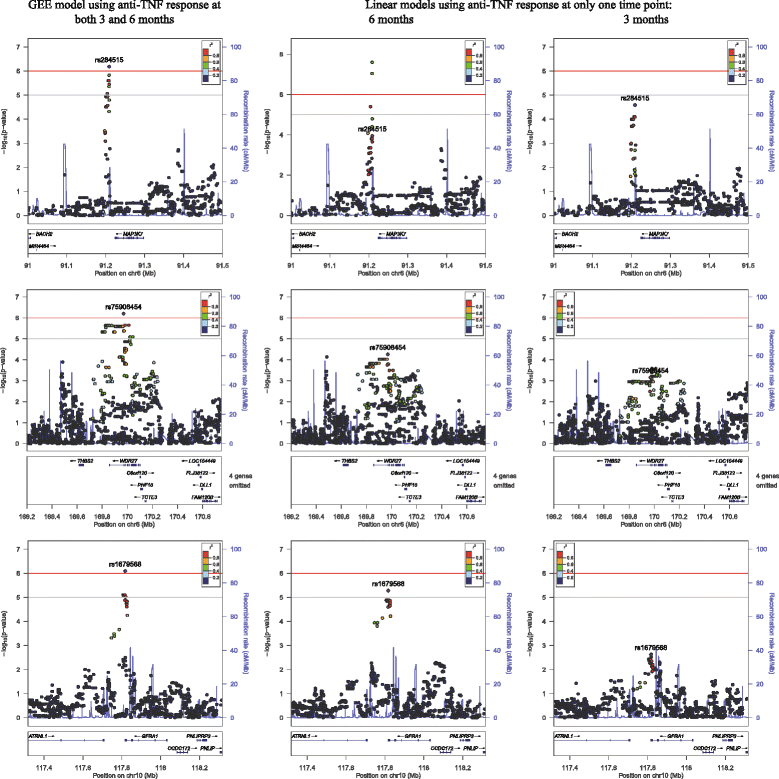A longitudinal genome-wide association study of anti-tumor necrosis factor response among Japanese patients with rheumatoid arthritis
- PMID: 26776603
- PMCID: PMC4718049
- DOI: 10.1186/s13075-016-0920-6
A longitudinal genome-wide association study of anti-tumor necrosis factor response among Japanese patients with rheumatoid arthritis
Abstract
Background: Studies of Caucasian patients with rheumatoid arthritis (RA) to identify genetic biomarkers of anti-tumor necrosis factor (TNF) response have used response at a single time point as the phenotype with which single nucleotide polymorphism (SNP) associations have been tested. The findings have been inconsistent across studies. Among Japanese patients, only a few SNPs have been investigated. We report here the first genome-wide association study (GWAS) to identify genetic biomarkers of anti-TNF response among Japanese RA patients, using response at 2 time-points for a more reliable clinical phenotype over time.
Methods: Disease Activity Scores based on 28 joint counts (DAS28) were assessed at baseline (before initial therapy), and after 3 and 6 months in 487 Japanese RA patients starting anti-TNF therapy for the first time or switching to a new anti-TNF agent. A genome-wide panel of SNPs was genotyped and additional SNPs were imputed. Using change in DAS28 scores from baseline at both 3 (ΔDAS-3) and 6 months (ΔDAS-6) as the response phenotype, a longitudinal genome-wide association analysis was conducted using generalized estimating equations (GEE) models, adjusting for baseline DAS28, treatment duration, type of anti-TNF agent and concomitant methotrexate. Cross-sectional analyses were performed using multivariate linear regression models, with response from a single time point (ΔDAS-3 or ΔDAS-6) as phenotype; all other variables were the same as in the GEE models.
Results: In the GEE models, borderline significant association was observed at 3 chromosomal regions (6q15: rs284515, p = 6.6x10(-7); 6q27: rs75908454, p = 6.3x10(-7) and 10q25.3: rs1679568, p = 8.1x10(-7)), extending to numerous SNPs in linkage disequilibrium (LD) across each region. Potential candidate genes in these regions include MAP3K7, BACH2 (6q15), GFRA1 (10q25.3), and WDR27 (6q27). The association at GFRA1 replicates a previous finding from a Caucasian dataset. In the cross-sectional analyses, ΔDAS-6 was significantly associated with the 6q15 locus (rs284511, p = 2.5x10(-8)). No other significant or borderline significant associations were identified.
Conclusion: Three genomic regions demonstrated significant or borderline significant associations with anti-TNF response in our dataset of Japanese RA patients, including a locus previously associated among Caucasians. Using repeated measures of response as phenotype enhanced the power to detect these associations.
Figures

Similar articles
-
Genome-wide association study and gene expression analysis identifies CD84 as a predictor of response to etanercept therapy in rheumatoid arthritis.PLoS Genet. 2013 Mar;9(3):e1003394. doi: 10.1371/journal.pgen.1003394. Epub 2013 Mar 28. PLoS Genet. 2013. PMID: 23555300 Free PMC article.
-
Lack of replication of genetic predictors for the rheumatoid arthritis response to anti-TNF treatments: a prospective case-only study.Arthritis Res Ther. 2010;12(2):R72. doi: 10.1186/ar2990. Epub 2010 Apr 27. Arthritis Res Ther. 2010. PMID: 20423481 Free PMC article.
-
The role of eight polymorphisms in three candidate genes in determining the susceptibility, phenotype, and response to anti-TNF therapy in patients with rheumatoid arthritis.Clin Exp Rheumatol. 2012 Nov-Dec;30(6):939-42. Epub 2012 Dec 17. Clin Exp Rheumatol. 2012. PMID: 22992305
-
Systematic review and meta-analysis: pharmacogenetics of anti-TNF treatment response in rheumatoid arthritis.Pharmacogenomics J. 2017 Oct;17(5):403-411. doi: 10.1038/tpj.2017.26. Epub 2017 Jun 13. Pharmacogenomics J. 2017. PMID: 28607508 Free PMC article. Review.
-
Tumour necrosis factor alpha -308G->A polymorphism is not associated with response to TNFalpha blockers in Caucasian patients with rheumatoid arthritis: systematic review and meta-analysis.Ann Rheum Dis. 2010 Jun;69(6):1022-8. doi: 10.1136/ard.2009.117622. Epub 2009 Dec 4. Ann Rheum Dis. 2010. PMID: 19966089 Review.
Cited by
-
Pharmacogenetics of Drug Therapies in Rheumatoid Arthritis.Methods Mol Biol. 2022;2547:527-567. doi: 10.1007/978-1-0716-2573-6_19. Methods Mol Biol. 2022. PMID: 36068476
-
Longitudinal method comparison: modeling polygenic risk for post-traumatic stress disorder over time in individuals of African and European ancestry.Front Genet. 2024 May 16;15:1203577. doi: 10.3389/fgene.2024.1203577. eCollection 2024. Front Genet. 2024. PMID: 38818035 Free PMC article.
-
Evaluation of 12 GWAS-drawn SNPs as biomarkers of rheumatoid arthritis response to TNF inhibitors. A potential SNP association with response to etanercept.PLoS One. 2019 Feb 28;14(2):e0213073. doi: 10.1371/journal.pone.0213073. eCollection 2019. PLoS One. 2019. PMID: 30818333 Free PMC article.
-
A genome-wide screen for variants influencing certolizumab pegol response in a moderate to severe rheumatoid arthritis population.PLoS One. 2022 Apr 12;17(4):e0261165. doi: 10.1371/journal.pone.0261165. eCollection 2022. PLoS One. 2022. PMID: 35413058 Free PMC article.
-
Mechanisms underlying DMARD inefficacy in difficult-to-treat rheumatoid arthritis: a narrative review with systematic literature search.Rheumatology (Oxford). 2022 Aug 30;61(9):3552-3566. doi: 10.1093/rheumatology/keac114. Rheumatology (Oxford). 2022. PMID: 35238332 Free PMC article. Review.
References
-
- Elliott MJ, Maini RN, Feldmann M, Kalden JR, Antoni C, Smolen JS, et al. Randomised double-blind comparison of chimeric monoclonal antibody to tumour necrosis factor alpha (cA2) versus placebo in rheumatoid arthritis. Lancet. 1994;344(8930):1105–1110. doi: 10.1016/S0140-6736(94)90628-9. - DOI - PubMed
-
- Barrera P, van der Maas A, van Ede AE, Kiemeney BA, Laan RF, van de Putte LB, et al. Drug survival, efficacy and toxicity of monotherapy with a fully human anti-tumour necrosis factor-alpha antibody compared with methotrexate in long-standing rheumatoid arthritis. Rheumatology (Oxford) 2002;41(4):430–439. doi: 10.1093/rheumatology/41.4.430. - DOI - PubMed
-
- Umicevic Mirkov M, Janss L, Vermeulen SH, van de Laar MA, van Riel PL, Guchelaar HJ, et al. Estimation of heritability of different outcomes for genetic studies of TNFi response in patients with rheumatoid arthritis. Ann Rheum Dis. 2015;74(12):2183–2187. doi: 10.1136/annrheumdis-2014-205541. - DOI - PubMed
Publication types
MeSH terms
Substances
LinkOut - more resources
Full Text Sources
Other Literature Sources
Medical
Research Materials
Miscellaneous

